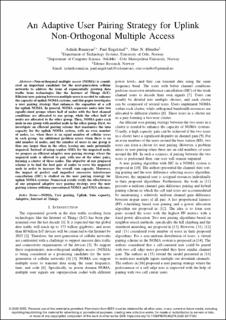| dc.contributor.author | Rauniyar, Ashish | |
| dc.contributor.author | Engelstad, Paal E. | |
| dc.contributor.author | Østerbø, Olav Norvald | |
| dc.date.accessioned | 2021-09-02T06:11:04Z | |
| dc.date.available | 2021-09-02T06:11:04Z | |
| dc.date.created | 2021-01-31T23:01:49Z | |
| dc.date.issued | 2020-10-08 | |
| dc.identifier.isbn | 978-1-7281-4491-7 | |
| dc.identifier.isbn | 978-1-7281-4490-0 | |
| dc.identifier.issn | 2166-9589 | |
| dc.identifier.issn | 2166-9570 | |
| dc.identifier.uri | https://hdl.handle.net/11250/2772357 | |
| dc.description.abstract | Non-orthogonal multiple access (NOMA) is consid-ered an important candidate for the next-generation cellular networks to address the issue of exponentially growing data traffic from technologies like the Internet of Things (IoT). Efficient user pairing between multiple users is needed to enhance the capacity of uplink NOMA systems, and this paper investigates a user pairing strategy that enhances the capacities of a cell for uplink NOMA. In general, NOMA separates nodes into two equally-sized groups where half of nodes with the best channel conditions are allocated to one group, while the other half of nodes are allocated to the other group. Then, NOMA pairs each node in one group with another node in the other group. First, we investigate an efficient pairing scheme that maximizes the sum capacity for the uplink NOMA system, with an even number of nodes, i.e. when there is an equal number of cellular users in each group. An additional problem arises when there is an odd number of nodes, and the number of users in one group is thus one larger than in the other, leaving one node potentially unpaired. Instead of using regular OMA for the unpaired node, we propose an efficient adaptive user pairing strategy where the unpaired node is allowed to pair with one of the other pairs, forming a cluster of three nodes. The objective of our proposed scheme is to find the best pair of nodes to serve the unpaired node in order to increase the overall sum capacity. Moreover, the impact of perfect and imperfect successive interference cancellation (SIC) is studied on the user pairing strategy for uplink NOMA systems. Numerical results verify the effectiveness of our proposed adaptive user pairing strategy over the user pairing scheme utilizing conventional NOMA and OMA schemes. | en_US |
| dc.language.iso | eng | en_US |
| dc.publisher | Institute of Electrical and Electronics Engineers | en_US |
| dc.relation.ispartof | 2020 IEEE 31st Annual International Symposium on Personal, Indoor and Mobile Radio Communications | |
| dc.relation.ispartofseries | IEEE International Symposium on Personal, Indoor, and Mobile Radio Communications workshops;2020 IEEE 31st Annual International Symposium on Personal, Indoor and Mobile Radio Communications | |
| dc.subject | Non-orthogonal multiple access | en_US |
| dc.subject | NOMA | en_US |
| dc.subject | User pairings | en_US |
| dc.subject | Uplinks | en_US |
| dc.subject | Sum capacities | en_US |
| dc.subject | Adaptive user pairing strategies | en_US |
| dc.subject | Internet of Things | en_US |
| dc.title | An Adaptive User Pairing Strategy for Uplink Non-Orthogonal Multiple Access | en_US |
| dc.type | Conference object | en_US |
| dc.description.version | acceptedVersion | en_US |
| dc.rights.holder | © 2020 IEEE | en_US |
| cristin.ispublished | true | |
| cristin.fulltext | original | |
| cristin.fulltext | postprint | |
| cristin.qualitycode | 1 | |
| dc.identifier.cristin | 1884539 | |
| dc.source.journal | IEEE International Symposium on Personal, Indoor, and Mobile Radio Communications workshops | en_US |
| dc.source.volume | 31 | en_US |
